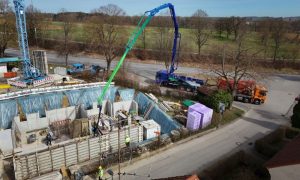HVAC: Keeping cool – and sustainable – in the Gulf
Experts from ETA Engineering on how cooling systems are evolving

With summer temperatures in the GCC reaching as high as 50°C, HVAC is not so much a luxury as a necessity in the region. Despite efforts to incorporate elements of natural cooling into buildings and architecture, the prevalent cooling trends remain firmly within the HVAC sphere.
However, with the region’s governments increasingly focused on promoting sustainability through the introduction of new regulations and the adoption of codes like ASHRAE, HARDI and SMACNA, local HVAC-focused companies are being tasked with adapting to a rapidly evolving market.
To get an idea of how the industry is gearing up to take on this challenge, Big Project ME spoke to three HVAC experts from one of the region’s best-respected MEP contractors, ETA Engineering. A division of the ETA Group, the company specialises in HVAC, electro-mechanical projects and services, and MEP work – including BMS, internal electrification and sub-station works.
Senior project directors Jacob John, Sreenivas and Mahmoud Mufleh Al Qammaz sat down to answer questions about how the industry is adapting to the new demands of the market.
Q: With the increased focus on sustainability and energy efficiency, how are HVAC-focused contractors adapting to the new demands of the market?
A: Speaking for ourselves, as an MEP contractor, ETA has worked jointly with the UAE government to ensure that facilities where we’re engaged are in compliance with sustainability and energy efficiency regulations.
It has become mandatory in the emirate of Abu Dhabi to comply with Estidama requirements, which is led by the UPC (Urban Planning Council). The authority has developed a point-based audit mechanism that rates a facility on sustainability and energy efficiency services in the following categories: Pearl I, Pearl II, Pearl III and Pearl IV, Pearl IV being the highest grade. The grading system is not just limited to HVAC, but to the whole building, from chillers to the waste management.
Economic growth is directly related to energy generation and consumption. With limited energy and water resources there is increased pressure on energy prices, which in turn leads to increased running costs and conservation becoming mandatory and no longer optional.
Industry, commercial and residential segments are among the major consumers (close to 60%) of electrical energy, so these business lines will always need to continuously innovate.
Q: What has been the impact of international and regional policies and standards governing the HVAC industry? What impact has the adoption and integration of standards and regulations like ASHRAE, HARDI and SMACNA had on future investments and project costs?
A: International and regional standards on sustainability and energy efficiency requirements would certainly provide a boost to the HVAC industry, as they improve overall performance of the building, reduce the running cost and provide environmental protection.
Though these benefits exist, implementation of these regulations comes at additional cost in terms of changed design and execution. We would suggest that investors take this into consideration and allocate higher budgets for project execution. One convincing aspect to this, though, is that the higher costs incurred on executing these guidelines can be offset by the reduction in running costs.
Beyond the mentioned international standards, the HVAC Industry in the Middle East is additionally governed by the following standards and norms:
• IKW/Ton: Full- and part-load efficiency metric. Typically used for water-cooled centrifugal and positive displacement chillers as per the ASHRAE 90.1 standard. Compliance can be achieved by meeting the requirements of either Path A or Path B.
• Compliance Path A is intended for applications where significant operating time is expected at full-load conditions. This is ideal for base-loaded chillers.
• Compliance Path B is an alternative set of efficiency levels for water-cooled chillers intended for applications where significant time is expected at part-load. It is ideal for trim-loaded chillers.
• AHRI 550/590: Standard used to rate chillers.
• EER (Energy Efficiency Ratio): Single efficiency rating point at full load at defined duty conditions.
• IPLV (Integrated Part-Load Value): Calculated from multiple efficiency rating points. Efficiency metric measures part-load conditions, with weighted average calculation of part-load scenarios.
• NPLV (Non-standard Part-Load Value): For non-AHRI 550/590 rating conditions. Applicable for non-standard operating conditions, within limits.
Q: What effect will these standards have on future project costs and investment plans?
A: The above-mentioned standards increase the cost of the project, but sometimes the end customer is not aware of the benefits. Electricity is by far the cheapest form of energy available for bulk consumers, which has been greatly subsidised by the state; this has thwarted the adaption and evolution of sustainable designs at home, for lack of user end incentives, until the state stepped in with regulatory bodies.
Multi-tier tariffs may be a reality in the near future, inferring from the imposed dynamic gas pricing. Usage of solar energy – available in abundance, neglected hitherto – may be sought after. However, in any built space with captive chillers, HVAC is the biggest power guzzler. Therefore, working in tandem with other industries – for instance, capturing the solar incidence on façade for supplementing power – benefits the user, the state and the environment.
Q: What best practices can be implemented for the installation, commissioning and maintenance of HVAC facilities?
A: Some of the best practices that should be implemented in HVAC facilities are:
• Usage of pre-fabrication techniques, non-steel piping for chilled water where possible, which resolves any architect-HVAC engineer conflicts in favour of running costs and maintainability of facility, over mere aesthetics.
• Third-party commissioning for ensuring that the designed conditions are delivered.
• Having an experienced and well-trained service team that is used for regular preventive maintenance as required by the installation, and not simply resorting to responding only to reactive calls, inherently destroying the longevity.
• Well-maintained BMS with all its peripherals (such as control valves, sensors, etc) is an asset and should never be undermined of its relevance.
• Usage of environmentally friendly refrigerant (with Zero Ozone depletion potential) equipment.
• Variable frequency drives can be used for saving a substantial amount of power.
• Air-cooled systems with efficiency close to that of water-cooled systems are preferred, to save on the usage of precious water and prevent related waterborne diseases.
• Adapting the use of district cooling, which reduces the initial cost as well as power required.
• Effective use of BMS to control the plant’s operating costs.
• Sufficient space for equipment installation and maintenance, walkways, etc.
There should also be an increased focus on U-values as well. Across HVAC facilities, there has been a consistent focus on improving architectural designs by providing the U-value, corresponding to high-spec materials.
At the execution part, the sustainability and energy efficiency requirements should be included in the procurement procedures so as to have all the materials comply. The installation, commissioning and maintenance should be as per the manufacturer’s recommendations.
For individual chillers, staging and sequencing multiple compressors and the use of variable speed drives and motors should be encouraged.
For chiller plants:
• Staging of multiple chillers – consider efficiency curves for each chiller, to maximise plant efficiency for any given load.
• Base-loaded chillers – these chillers should operate for much of the time at or near to full loads, to maximise full-load efficiency (recommended Path A method).
It is important to consider these matters from the early stage of design. Not only in HVAC, but also during the architectural design phase, by providing the U-value corresponding to high-spec materials, sufficient space for equipment installation and maintenance, walkways, etc.
Q: How has HVAC design has evolved, and how will it grow over time?
A: HVAC systems have changed the way buildings are designed, built and occupied, thereby allowing investors and contractors to build bigger, taller and increasingly massive MEP facilities. It is now possible to ventilate and fully condition the air that comes into a building.
The evolution of electronics in equipment has made HVAC systems smarter, smaller and more efficient. They have reshaped how the systems are installed, how they are maintained and how they operate. Furthermore, the widespread use of electric motors and drives, microprocessors and increased automation have improved the efficiency of systems and enabled the accurate monitoring of their performance.
Going forward, increased energy costs, consequent to rapidly depleting reserves, and growing environmental restrictions will help to continue the evolution of the HVAC market segment in the future. There is a greater necessity to approach the design of built environments holistically and not merely exerting thrust on HVAC.
The implementation of the sustainability and energy efficiency requirements should take place at the design stage of the HVAC system. Consideration should be given to some main key issues, such as the COP (coefficient of performance) for chillers, SFP (specific fan power) for FAHU, AHU, FCU and fan. There are also some secondary issues that can be implemented, such as the refrigerant recovery system (RRS) and gas leak detection system.















